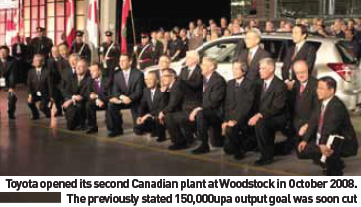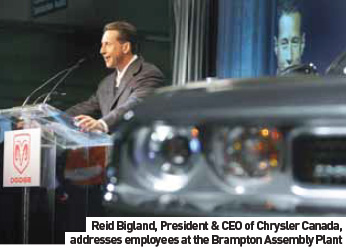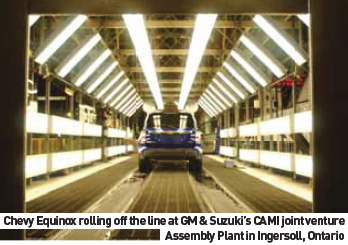Throw a stone seemingly anywhere in Ontario and chances are it will land somewhere near either a parts or vehicle manufacturing facility. Home to OEM operations of companies such as GM, Ford, Chrysler, Honda, Toyota and Suzuki, plus Tier suppliers Magna International and Linamar, these organizations have successfully worked with both the regional government in Toronto and federal authorities in Ottawa to maintain sustainable levels of investment.
Whilst large-scale cutbacks have been necessary, it is worth noting that even as the credit crunch was taking huge bites out of consumer confidence, Toyota, a long-time investor in Ontario, chose to push on with the opening of its second Canadian plant.
Located in Woodstock, Ontario, the plant opened in December 2008, joining the other plant in nearby Cambridge. While both currently continue to build SUVs, Toyota’s US-based light truck plants have been idled.
Further, the downturn prompted a rethink of Toyota’s planned Mississippi plant, due to build the Highlander SUV. Even though plans were swiftly switched to assembling the Prius hybrid and the facility’s build schedule slowed, all production plans for this site were recently placed on indefinite hold.
So how has Ontario, not a major manufacturing powerhouse in global terms, avoided the wholesale collapse of investment that has decimated US manufacturing? The short answer is focussed partnerships between business and government.
Rather than adopting a wait-and-see approach to the financial crisis, the federal and Ontario governments stated in December last year that they would provide Canadian subsidiaries of the Detroit Three vehicle manufacturers with CAD 3.29bn in emergency loans, the prime minister himself making the announcement. The news came only days after former president George W. Bush offered a $17.4bn package of crisis financing to General Motors, Ford and Chrysler LLC.
"We cannot afford, in the United States or Canada, the catastrophic short-term collapse of the Big Three automakers. The US has signalled that they are not going to allow these companies to fail, and we will do our share of the North American package to see that this doesn't happen either," said Prime Minister Stephen Harper.
 A giant country by area, but with a population less than a tenth of its southern neighbour, it could be thought that Canada would be better off leaving vehicle and parts manufacturing to other industrialised nations. But the country’s various layers of government work closely with one another, often across partisan lines, as they know not just huge numbers of jobs are at stake but also industrial expertise.
A giant country by area, but with a population less than a tenth of its southern neighbour, it could be thought that Canada would be better off leaving vehicle and parts manufacturing to other industrialised nations. But the country’s various layers of government work closely with one another, often across partisan lines, as they know not just huge numbers of jobs are at stake but also industrial expertise.
More than 517,000 Canadians work directly for OEMs and suppliers or are reliant on related firms, claims Ontario’s Ministry of Economic Development. The industry represents 14% of the national manufacturing output, as well as 23% of manufactured exports. Moreover, the automotive industry is the country’s largest in terms of manufacturing.
One of the innovative solutions that has begun to help suppliers in Ontario is additional accounts receivable insurance coverage, made available through the federal Export Development Canada. A new facility has recently been created to provide access to consumer credit for car loans and dealer financing. In January, while the US new vehicle market plunged 37%, in Canada, the equivalent fall was only 25%.
Examples abound of firms that have managed to find a way through the ongoing economic crisis and not all are giants with access to cashflow from overseas headquarters, such as Denso Canada or Toyota Motor Corporation.
One such firm is PM Plastics, based in Windsor, where not only have existing jobs been saved, but new ones have been created. How has this supplier thrived in a climate that has taken others elsewhere to the wall, especially in light of sharing its location with an embattled Chrysler minivan plant? The answer is selective government investment and in this case, a grant provided in accordance with green technology guidelines.
The case of PM Plastics deserves further exploration, serving as an example of how targeted funding is being used to maintain a supply base for the time when the new vehicle market recovers. In this case, the grant totals only CAD 565,300, but it supports the company’s own investment of CAD 3.77m over the next five years. A specialist manufacturer of automotive fuel and air induction systems, PM Plastics must use the government money to commercialise and manufacture components for alternative energy based vehicles, including components for hybrid vehicles.
Michael Bryant, Minister of Economic Development, explains the thinking behind the programme of grants.
“Part of the Ontario government’s economic strategy is to support companies that are creating jobs in the green and high-tech sectors. These sectors are creating the jobs people want and helping to secure Ontario’s position as a premiere destination for investment and innovation.”
The successes and support that some suppliers are enjoying should, however, be set against a potentially darker scenario – that of the US new vehicle market remaining in its deep recession. In January alone, Chrysler’s US sales fell by a near-unbelievable 70%, this in the market that is the final destination for a large percentage of Canada’s locally-made parts. The parent company has two vehicle plants in Ontario, one of which is the only source of Chrysler LLC’s big rearwheel drive sedans and coupes, sales of which have gone through the floor.
 A potential shuttering of either its Windsor or Brampton plants is something Chrysler wants to avoid at all costs as the vehicles built there are vital for its planned US sales recovery. Further, Windsor also makes vehicles for global markets and is the host plant for contracted production of the Volkswagen Routan minivan, a version of its own Dodge Grand Caravan and Chrysler Town & Country. Chrysler Canada has therefore submitted detailed restructuring plans to the Ontario and federal governments, following a request from both federal and provincial ministers.
A potential shuttering of either its Windsor or Brampton plants is something Chrysler wants to avoid at all costs as the vehicles built there are vital for its planned US sales recovery. Further, Windsor also makes vehicles for global markets and is the host plant for contracted production of the Volkswagen Routan minivan, a version of its own Dodge Grand Caravan and Chrysler Town & Country. Chrysler Canada has therefore submitted detailed restructuring plans to the Ontario and federal governments, following a request from both federal and provincial ministers.
“Our request for a temporary and fully-repayable loan from the Ontario and Canadian governments is really twofold,“ explains Reid Bigland, President and Chief Executive of Chrysler Canada.
“First, to ensure Chrysler has sufficient funds to complete our restructuring activities during what is an unprecedented downturn in vehicle sales caused by the global financial crisis. Second, to ensure Chrysler Canada's substantial Canadian manufacturing and operational footprint is protected."
The Michigan based firm knows that to be able to secure and retain ongoing funding to help with its restructuring, it needs to work closely with governments across the border.
So its strategic plan focuses on clear targets. Namely, investments in new vehicles and technologies (new rear drive models for Brampton are due from 2010), major reductions in fixed costs and the formation of further strategic alliances and partnerships.
A bridging loan will, Bigland believes, allow Chrysler Canada to move to the next stage of its ongoing restructuring process. The Cerberus and Daimler-controlled OEM has, however, not revealed the size of its financing request. With just under 10,000 workers in Ontario, based at its Windsor headquarters, the two assembly sites and a third facility, a casting plant south-west of Toronto, the firm is still a major employer despite a downsizing in the latter half of 2008. Further cuts do seem inevitable, however, as fully 86% of the more than 500,000 vehicles it assembles per year traditionally go to the US market.
The Canadian government, which is of course accountable to tax payers, has prudently been war-gaming a doomsday scenario. It is refreshingly candid about what may lie ahead.
According to Ontario’s Ministry of Economic Development, Canada as a whole could lose more than 580,000 jobs within five years if GM, Ford and Chrysler were to be forced into bankruptcy.
 There have already been plant closures and idlings, together with shift cuts, but were auto output by US-based manufacturers in Canada to halve, the ministry estimates that at least 157,400 jobs would be lost right away, 141,000 of them in Ontario. Looking ahead to 2014, the number of job losses would reach 296,000 at a national level, 269,000 of those in Ontario.
There have already been plant closures and idlings, together with shift cuts, but were auto output by US-based manufacturers in Canada to halve, the ministry estimates that at least 157,400 jobs would be lost right away, 141,000 of them in Ontario. Looking ahead to 2014, the number of job losses would reach 296,000 at a national level, 269,000 of those in Ontario.
"The depreciation of the dollar, lower interest rates and lower production costs eventually help the economy to partially recover (over the following five years, 2015 to 2019) but the loss of the Detroit Three leaves a permanent dent in Canada's economy in terms of jobs and output," predicts a new report by the Ontario Manufacturing Council.
The document bluntly examines the likely look of a post-industrial province if governments in Ottawa and Washington refuse to fully support GM, Ford and Chrysler.
"For any Canadians who feel that the auto industry is expendable to our economy, this report is a wake-up call," proclaims Michael Bryant, Minister for Economic Development.
Says Bryant: "The report suggests that even under a scenario where half the auto sector is lost, our economy (Ontario) basically craters and brings the whole rest of the (national) economy with it."
Some industry watchers were alarmed to witness Toyota becoming the US market’s number one brand in 2008, dethroning Chevrolet and also surpassing Dodge in light truck sales for the first time. They believe that the disappearance of one or more of the Detroit Three would lead to the domination of manufacturing in not just Canada but throughout North America by Toyota, Honda, Nissan and to a lesser extent Hyundai-Kia and Volkswagen. Not so, says this same report: "The economic impacts estimated by this analysis are likely to understate the true economic impact for several reasons, despite the possibility that foreign vehicle producers could expand production in Canada."
The real threat to the indigenous industry may not be anything at all to do with the ongoing financial crisis, resultant recession and possible closures of GM, Ford and/or Chrysler manufacturing operations.
Another danger that had been seen, but more or less steadily seen off, reappeared last year. For all the effort that has gone into retaining and encouraging more investment in a highly educated and skilled workforce, a psychological blow was struck to the Canadian industry from an old adversary. In 2008, Mexico overtook the country for the first time in terms of numbers of vehicles built.
When vehicle production in Mexico reached 1.796 million units for the first 10 months of last year, that was enough to push Canada into third place in the region. For the record, the equivalent number for Canada was 1.779 million cars and trucks.
It’s not just the investment by the likes of GM, Volkswagen, Nissan and Ford in existing and new Mexican plants that is tipping the scales. Crucially, many suppliers are also increasingly tempted to shift operations out of Ontario, following the major OEMs.
Bryant sees this shift causing problems for Canadian carmakers should the process begin to accelerate. "The tentacles of the auto makers in Detroit reach into Canada in a number of ways. Firstly the automakers, secondly the dealers and thirdly, and very importantly, the suppliers," he says. "We have to ensure that every supplier and every part of the supply chain is recognized in the North American solution." Part of his proposed solution to this challenge has been the provision attached to loans for the Canadian arms of the Detroit Three. In simple terms, they must use such funds to pay suppliers, Bryant insists.
For their part, major and minor suppliers have been increasingly vocal in their lobbying of government for support, not just for their own operations, but vitally for those of their OEM customers operating in Canada. Linamar Corporation’s CEO Linda Hasenfratz has met directly with Harper, pressing the prime minister to keep all options open and to maintain support for vendors and auto makers alike as vehicle sales continue to remain distressed.
"Many suppliers are in a very, very difficult financial position at the moment, with very poor liquidity because of years of production reductions in North America, capped off this year by some pretty extreme reductions in volume," she states.
Hasenfratz believes the regional and federal authorities should be actively pushing new initiatives, such as the extension of additional financing to GM, Ford and Chrysler. Further, she wants a stipulation that such funding would be used to pay suppliers within 20 days instead of the existing 60-day period that the industry has traditionally worked under.
Chrysler LLC, Brampton: Chrysler 300 sedan and wagon, Dodge Charger sedan, Dodge Challenger coupe
Chrysler LLC, Windsor: Chrysler Town & Country minivan, Chrysler Grand Voyager minivan, Dodge Grand Caravan minivan, Volkswagen Routan minivan
Ford, Oakville: Edge crossover, Flex crossover, Lincoln MKT crossover, Lincoln MKX crossover
Ford, St Thomas (due for closure in 2010): Flex Crown Victoria sedan, Lincoln Town Car sedan, Mercury Grand Marquis sedan
General Motors, Oshawa 1 & 2: Buick Allure sedan (replacement shifts to Fairfax, Kansas), Buick LaCrosse sedan (replacement shifts to Fairfax, Kansas), Chevrolet Camaro coupe, Chevrolet Camaro convertible (2010), Chevrolet Impala sedan, Chevrolet Silverado pick-up & 1500 Hybrid pick-up, GMC Sierra pick-up & 1500 Hybrid pick-up
General Motors-Suzuki, Ingersoll (CAMI): Chevrolet Equinox SUV, Suzuki XL-7 SUV (to be discontinued in 2009), Suzuki Grand Escudo XL-7 (to be discontinued in 2009)
Honda, Alliston 1 & 2: Acura CSX sedan, Acura MDX crossover, Honda Civic sedan
Toyota, Cambridge: Lexus RX 350 crossover, Toyota Corolla sedan, Toyota Matrix hatchback
Toyota, Woodstock: Toyota RAV4 SUV
The cash flow difficulties facing Tier companies are certainly of huge concern to their shareholders and customers. Yet other dangers lurk in the supply chain and are steadily working their way to the top of the combined list of concerns facing OEMs, suppliers and governments alike.
 Many now worry that endless cost cutting may provoke agitation by the Canadian Auto Workers. The union, which blockaded the headquarters of GM Canada last year following the announcement of a plant shuttering, claims it knows it must help to improve competitiveness but has resisted contract amendments.
Many now worry that endless cost cutting may provoke agitation by the Canadian Auto Workers. The union, which blockaded the headquarters of GM Canada last year following the announcement of a plant shuttering, claims it knows it must help to improve competitiveness but has resisted contract amendments.
One of the attractions of Ontario has been the state funded health care system, but with the new administration in the US committed to bringing in its own national scheme, worker costs in Canada will be under the microscope as never before. Workers’ wages are already under pressure, with some analysts believing that OEMs and suppliers now need wages and benefits to fall by $15 to $20 an hour for their operations to remain viable.
Much depends on what happens in the US. If GM, Ford and Chrysler push their workers’ wages even lower, falling into line with those of the non-organised Japanese, German and Korean transplants, Canadian plants will be at a major disadvantage. Unionised workers in Ontario make the equivalent of USD 67/hour in wages and benefits, with the US and Canadian currencies at parity. However, the Canadian currency is notoriously volatile, particularly against the greenback. At 80 cents to the US dollar, the CAW states that its members’ wages drop to only USD 53.60.
Clearly, this an argument that is only going to intensify.
The Canadian Auto Workers says that US-based workers now make an average of $58/hour (wages and benefits), but warns that this continues to fall following the new two tier contract between the United Auto Workers and the Detroit Three. By contrast, at Toyota’s Georgetown facility in Kentucky, home of the hugely successful Camry, ‘associates’ earned roughly $49/hour in wages and benefits – with this being one of the better-paid workforces in the region, according to union claims.
The US government’s $17bn aid package stipulates that the three Detroit-based firms must shift their working structures into line with those operated by Toyota, Honda and Nissan’s leanest plants. The UAW, while resisting further pain for its workers, nevertheless acknowledges that its members are expecting to have to give up further gains in exchange for job security, just as the CAW has grudgingly acknowledged.
What is needed more than just further cost cutting in all its forms, is the return of vehicle buyers to the market to generate the investment capital needed to develop the models Canadian workers would like to be building in the rapidly approaching new decade. Optimists do exist, though naturally, they are cautious. Perhaps surprisingly, two of the three US automakers are amongst those prepared to publicly hold out hope that the storm will indeed pass.
 "GM…is well positioned to respond to (the) improving consumer credit and confidence we hope and expect to see in the months ahead as government stimulus efforts and other factors start to take hold in Canada," the company’s sales and marketing chief Marc Comeau stated as production of the all-new Chevrolet Camaro and Equinox models got underway at two different Ontario plants.
"GM…is well positioned to respond to (the) improving consumer credit and confidence we hope and expect to see in the months ahead as government stimulus efforts and other factors start to take hold in Canada," the company’s sales and marketing chief Marc Comeau stated as production of the all-new Chevrolet Camaro and Equinox models got underway at two different Ontario plants.
Ford also sees signs of better times ahead with its sales off only 14.1% in January - this while the overall market fell by a quarter.
"There's no doubt that 2009 will be a challenging year, but at Ford of Canada, we continue to outperform the industry and are positioning ourselves for profitable growth in the future," the division’s President and CEO David Mondragon adds, noting that the Canadian-built Flex, a large crossover model, achieved its best month of sales in January since being launch in June last year. This was also the fifth consecutive month of sales increases for the model.
Any number of factors could yet derail even the most modest of recoveries and yet more rounds of painful downsizing can by no means be ruled out. The fundamentals of Canada’s manufacturing industry are nevertheless sound and its enlightened industrial policies are clearly being adapted for the realities of troubled times.
Canadian plants, let us not forget, are consistently ranked towards the top of productivity and quality indexes, these two factors until recently usually offsetting higher wage rates. And should the CAW reopen contracts or provide concessions on compensation as seems inevitable, it is by no means certain that the country’s automotive industry as a whole should not be able to reinvent itself yet again.
Traditionally, Ontario has produced some of GM, Ford and Chrysler’s biggest gas guzzlers, but the province is steadily seeing a shift towards not only smaller models such as the Honda Civic, but vehicles with hybrid and other low-emission powertrains.
Magna International recently revealed that it was the driving force behind an electric car JV with Ford Motor Company. The partners recently showed an electric Focus sedan prototype. Expected to have a 100-mile range, this derivative of the next generation of Ford’s global small car will be powered by lithium-ion batteries.
“Our collaboration with Magna on a Ford BEV [Battery Electric Vehicle] is the result of a shared vision of the potential of electrification in transportation,” Derrick Kuzak, Ford’s Group Vice President of Product Development notes. “This partnership leverages the technical expertise of two global companies to achieve a common goal, delivering a nocompromise, zero-emission, battery-powered car for the retail market.”
Production targets are modest, with Magna saying only that it hopes for some 5,000upa in the first year. The Canadian Tier One is contracted to supply all powertrain components, as well as the battery module.
To ease assembly and lower costs, the car’s electric propulsion system will be integrated into the vehicle architecture. Magna is developing a single-speed transmission, high-voltage designs for the HVAC compressor and auxiliary heater, while an on-board battery charger can be plugged in to a 110- or 220-volt standard outlet.
“We strongly believe in collaboration because it drives innovation and keeps costs down,” says Don Walker, co-Chief Executive of Magna International.
While Magna has been investing heavily in electric car R&D componentry, a California-based start-up, Project Better Place has launched a partnership with the Ontario government to get such vehicles onto Canadian roads. This same fi rm has launched JVs the world over with the Renault-Nissan Alliance, with electric models of both brands’ small to mid-sized sedans under development for launch in regions such as southern Europe, the coastal United States, Israel and Australia.
In selecting to encourage Better Place to invest in the province, the regional government is hedging its bets for the inevitable move towards more alternative fuel vehicles. Yet while gasoline prices continue to be so volatile, it is diffi cult to justify huge spending on new technology when consumers in North America, at least, continue to buy large numbers of heavy SUVs and full-size pickups. Ontario and Better Place believe they have found the answer to this conundrum. Their shared strategy combines the following factors:
- Financial incentives to encourage the purchase of electric vehicles
- Preferred access to the transportation grid to encourage the adoption of electric vehicles
- Forward-looking procurement policies to speed government adoption of electric vehicles into fleet services where appropriate
- Co-ordinated public education and promotion of electric vehicles as a mode of personal transportation
- The development of an electric car charging network
“As a major auto producer with significant manufacturing expertise and facilities, Ontario stands to benefit from the inevitable and accelerating shift to electric cars,” Shai Agassi, Better Place’s CEO and founder believes. Announcing the initiative alongside government officials, he adds, “Transition to the Car 2.0 model of electric vehicles powered by renewable energy presents an historic opportunity for Ontario and Canada to help lead the world in economic growth and environmental recovery for the next century.”


































